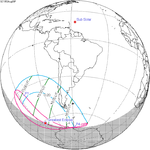Solar_eclipse_of_September_1,_1951
Solar eclipse of September 1, 1951
20th-century annular solar eclipse
An annular solar eclipse occurred on Saturday, September 1, 1951. A solar eclipse occurs when the Moon passes between Earth and the Sun, thereby totally or partly obscuring the image of the Sun for a viewer on Earth. An annular solar eclipse occurs when the Moon's apparent diameter is smaller than the Sun's, blocking most of the Sun's light and causing the Sun to look like an annulus (ring). An annular eclipse appears as a partial eclipse over a region of the Earth thousands of kilometres wide. Annularity was visible from the United States, Spanish Sahara (today's West Sahara), French West Africa (the parts now belonging to Mauritania, Mali, Burkina Faso and Ivory Coast), British Gold Coast (today's Ghana), southern tip of French Equatorial Africa (the part now belonging to R. Congo), Belgian Congo (today's DR Congo), Northern Rhodesia (today's Zambia), Portuguese Mozambique (today's Mozambique), Nyasaland (today's Malawi), and French Madagascar (today's Madagascar).












































